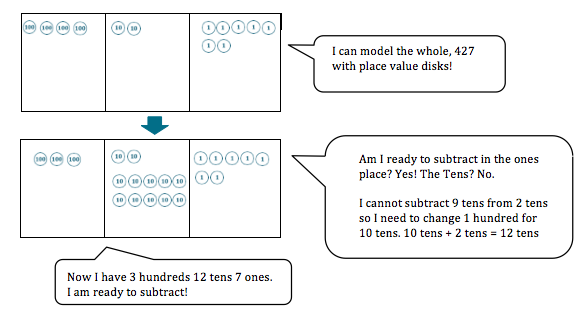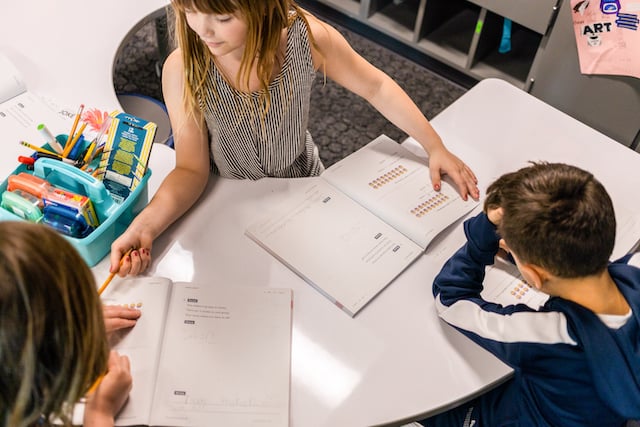Posted in: Aha! Blog > Eureka Math Blog > Conceptual Understanding > How to Promote a Deeper Understanding of Place Value
COHERENCE
When I was a second grader, I thought place value was fairly dull.
Teacher: How many ones are in 427?
Student: 7
Teacher: How many tens?
Student: 2
Not true. That would be true if the teacher had asked, “How many tens are in the tens place?” or “How many ones are in the ones place?” The truth is that 427 has 42 tens (or more technically 42.7 tens) and 427 ones. Even as a young educator, the following relationship between measurement and place value units never occurred to me.
4 yards 2 feet 7 inches = 14 feet 7 inches = 175 inches
4 hundreds 2 tens 7 ones = 42 tens 7 ones = 427 ones
What I know now is that I can interpret 427 in an infinite number of ways, e.g. as 4270 tenths, 42,700 hundredths, … (not to mention 61 sevens, 854 halves). A three-digit number is comprised of 3 place value units that can be decomposed and manipulated.
As a child and a young educator my understanding of place value was solely based on looking at a column. My mathematical understanding was superficial, void of the part/whole thinking that we want for our students. No wonder place value seemed dull to me.
Place Value Understanding Begins in Kindergarten
In Eureka Math, kindergarten kicks off with students immersed in counting objects, such as: teddy bear counters, erasers, crayons, sticks, etc. Numbers are adjectives describing units, 4 teddy bears, 5 erasers, etc. By the end of the year, kindergartners can organize and count a pile of 14 sticks as a group of 10 ones and 4 ones (K.CC.3). This new unit of “one” is the foundational unit that sets the stage for place value understanding. Students learn to count both the regular way and the East Asian Way[1] (we call this “Say Ten” counting in Eureka Math.). For example, students count 14 sticks as “…ten 1, ten 2, ten 3, ten 4” (shown below). Since our teen number words do not support the base-ten structure, counting the “Say Ten” way really celebrates the importance of ten. After spending some time working with objects, students record teen decompositions with a number bond and a number sentence, e.g., 14 = 10 + 4.

It’s important to note that Kindergartners only compose and decompose teen numbers in terms of “ones.” So, while it is tempting to bundle those 10 ones and introduce the new unit of “ten”, we save that big moment for Grade 1. This gives kindergartners, especially those who are still counting all, multiple opportunities to count and to find short cuts for counting ten faster. Let’s summarize the distinction:
Grade K: “14 is the same as 10 ones and 4 ones.”
Grade 1: “14 is the same as 1 ten and 4 ones.”
Place Value Understanding is Foundational for Addition and Subtraction
Addition
A Story of Units continues, and by the end of Grade 1 Module 2, students have identified a new unit, a “ten”. Armed with the understanding that they can now count units of ten (e.g., 3 tens, 4 tens, 5 tens, etc.), students see that a 2-digit number is comprised of both tens and ones. For example, 27 is a whole that can be decomposed into parts: e.g. 20 ones and 7 ones, or 2 tens 7 ones (1.NBT.2). In the image shown, students see the group of 10 marbles in each jar and the leftover 7 marbles outside the jar. They use the number bond to show the decomposition of 27 before representing it abstractly with a number sentence, e.g., 27 = 20 + 7 (Module 4 Lesson 4).
In the later half of Module 4, first graders practice renaming 2-digit numbers, seeing that you can bundle 10 ones to make 1 ten, or unbundle 1 ten to make 10 ones (Lesson 23). So,
27 = 2 tens 7 ones = 1 ten 17 ones = 27 ones

The Grade 1 Teach Eureka video series highlights how students can use their “magic counting sticks” (i.e., fingers) to model the number 30. Notice how the whole, 30, can be manipulated and decomposed in a variety of ways. This flexibility in interpreting a 2-digit number supports students when they decompose a number to solve with tens and ones, e.g., 27 + 8.

Notice how both students used place value understandings, part/whole thinking, and the associative property to solve. The first student decomposed 27 into tens and ones and “associated” the ones before adding 2 tens, e.g., (8 + 7) + 20. The second student saw what part 27 needs to make a ten and decomposed 8 to get it. This student “associated” 27 and 3 ones to complete a unit of ten, then added on 5 more to get 35.
This ability to compose and decompose a unit pays dividends when students begin adding and subtracting larger numbers in Grade 2 or decimals in Grade 5. The use of place value disks in Grade 2 plays an important role in students’ internalization of the meaning of each unit on the place value chart (2.NBT.1). Notice how students can still use the “make ten” strategy when combining ones in 27 + 58 (as shown below).

Take a moment and envision the place value chart above with ones and tenths instead of tens and ones. In the Grade 5 problem, 2.7 + 5.8, a student changes 10 tenths for 1 one. It is typical for students to fear the decimal point; however, when they see that decimals behave in exactly the same way, they begin to see the predictable structure inherent in place value understanding.

As an alternative, a student can just as easily solve the same problems using a number bond to make the next ten (Grade 2) or the next one (Grade 5).

Subtraction
Just as students can compose a new ten or hundred in Grade 2, they can also decompose a ten or a hundred, as in 427–193 (as shown below).

In Eureka Math, students draw a magnifying glass around the 3-digit minuend to remind them that the digits are part of a whole whose units can be decomposed (as shown below). Students change units, seeing that the value of the whole does not change: 427 = 3 hundreds 12 tens 7 ones.

Just as we saw with addition, all decimal numbers follow the same pattern, only the units change. Notice the analogous thought processes that a Grade 5 student uses to solve 4.27–1.93.

Just as with addition, students can also subtract using a variety of methods. While some may prefer the algorithm, others may see an opportunity to “take from a hundred” (Grade 2) or “take from a one” (Grade 5) and compute mentally.

This is flexible thinking at its finest, not to mention evidence that there is nothing dull about place value understanding.
Growing up, my ability to perform the algorithm lacked an understanding of the relationship among the place value units. I did not have a sense that 10 of one unit makes 1 unit of the next highest value. So, 10 tenths makes 1 one, 10 ones makes 1 ten, 10 tens makes 1 hundred, and so on. The reverse is also true: 1 hundred can be decomposed into 10 tens, 1 ten can be decomposed into 10 ones, etc. Years ago, I missed out on the fact that the 4 hundreds in 427 can be decomposed into 3 hundreds 10 tens, and that the little “1” I once placed in front of the “2” indicates 12 tens. The irony is that I aced every test.
[1] K-5 Progression on Number and Operations in Base Ten, p. 5
This post is by Eureka Math teacher-writer MaryJo Wieland.
© Great Minds 2016
Submit the Form to Print

MaryJo Wieland
Topics: Conceptual Understanding










